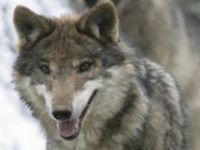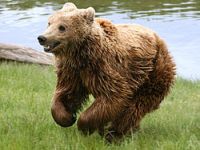Good news: Wildlife comeback in Europe
The successful return of species to their natural habitats - The Eurasian beaver, European bison and White-tailed eagle have all been highlighted as species that have made a remarkable comeback in Europe over the past 50 years, according to a first ever in-depth report released today (26 Sept).

Scientists from the Zoological Society of London (ZSL), BirdLife International and the European Bird Census Council (EBCC) worked with experts from across Europe to gather relevant data about the distribution and abundance of selected species. The resulting report, 'Wildlife Comeback in Europe', describes how, why and where 37 mammal and bird species have recovered over the past 50 years, providing important lessons for the conservation of these and other species.
Professor Jonathan Baillie, ZSL's Director of Conservation says: "It is essential that we both celebrate and learn from major successes in conservation. This study helps us understand the interventions and conditions necessary for a broad range of species to experience similar recoveries."
"Wildlife will bounce back if we allow it to - this report shows that", says Frans Schepers, Managing Director of Rewilding Europe. "With continued and strong legal protection, active boosting of existing wildlife populations and reintroductions to bring back lost species, combined with an increasing tolerance towards wildlife, more species will surely follow."
The White-tailed eagle, one of the largest birds of prey in the world, has made an impressive recovery following dramatic declines and extinctions in many countries between 1800 and 1970. Thanks to legal protection, the European population grew from fewer than 2,500 pairs in 1970 to 9,600 pairs in 2010, and the species has recently recolonised parts of its former range in northern and central Europe.
The European bison, the largest herbivore in Europe, went extinct in the wild in the early 20thcentury due to severe hunting pressure and habitat loss. After a large-scale breeding and reintroduction programme based on individuals remaining in captivity, wild populations have been re-established in areas of central and eastern Europe, with a stronghold in Poland and Belarus. The total population is now almost 3,000 individuals.
Gerben-Jan Gerbrandy, Member of the European Parliament and Rapporteur for Biodiversity says: "This report shows first of all the amazing resilience of nature. Furthermore, it emphasizes the importance of EU policy: the Birds and Habitats Directives, the Natura 2000 network of protected areas and the Water Framework Directive are all explicitly credited for supporting this impressive return of wildlife. The rewilding of Europe exceeds nature protection, because these iconic species create unique opportunities for rural development.
"I firmly believe that smart investments in nature create huge economic opportunities and I will continue to work vigorously in Brussels to turn the rewilding of Europe into reality," MEP Gerbrandy added.

The wildlife comeback is not limited to the species presented in this study; there are many more that are showing similar patterns of recovery. Despite the return of this impressive number of European birds and mammals, biodiversity is still being lost. The results of this report must be viewed in the context of large historical declines. For carnivores like the Eurasian lynx and Grey wolf, and many bird species including the Red kite, distributions and abundances had already declined dramatically from their historical levels by the mid-20th century. Wildlife resurgence must therefore be assessed cautiously, as many species have not yet reached the level necessary to secure sustainable populations.
http://www.birdlife.org/community/wp-content/uploads/2013/09/Wildlife-Comeback-in-Europe-the-recovery-of-selected-mammal-and-bird-species.pdf
Birdlife.org
The 'Wildlife Comeback in Europe' report is commissioned by Rewilding Europe, an organisation working to "Make Europe a Wilder place", with wildlife, wild nature, natural processes and the "Business case for the Wild" as some of its key elements.
The report was funded by valuable grants from the Swedish Postcode Lotteries, the Liberty Wildlife Fund and ARK Nature.
The wildlife comeback is not limited only to the wildlife species that are presented in this study; there are many more that we know are showing similar patterns of recovery. However, limited data, time and resources were reasons why these were not included in the report.
Gerben-Jan Gerbrandy will receive the first copy of the report of Wildlife Comeback in Europe at a special seminar in London on 26 September. MEP Gerbrandy is available for interviews on the 25th, you can contact him on +31 (0)6 22421716
ZSL
Founded in 1826, the Zoological Society of London (ZSL) is an international scientific, conservation and educational charity whose mission is to promote and achieve the worldwide conservation of animals and their habitats. Our mission is realised through our groundbreaking science, our active conservation projects in more than 50 countries and our two Zoos, ZSL London Zoo and ZSL Whipsnade Zoo. For more information visit www.zsl.org
BirdLife International
BirdLife is the world's largest nature conservation partnership, with national Partners in more than 120 countries, including almost 50 in Europe and Central Asia. Its mission is to conserve birds and all nature, working with people towards sustainability. BirdLife's unique local to global approach delivers high impact and long term conservation for the benefit of nature and people www.birdlife.org
European Bird Census Council (EBCC)
The European Bird Census Council (EBCC) is an association of like-minded expert ornithologists co-operating in a range of ways to improve bird monitoring and atlas work across Europe, and thereby inform and improve the management and conservation of bird populations. www.ebcc.info
Rewilding Europe
Rewilding Europe, founded in 2011, is an initiative that seeks to inspire a broad popular movement to shape a new, wilder version of Europe. Rewilding Europe is about making Europe a wilder place, with much more space for wildlife, wilderness and natural processes, bringing back the variety of life for us all to enjoy and exploring new ways for people to earn a fair living from the wild. www.rewildingeurope.com
Future events
This report will also be presented at the forthcoming X World Wilderness Congress (WILD10) in Salamanca, Spain, on October 4.
Prepared for Pravda.Ru by
Timothy Bancroft-Hinchey
Subscribe to Pravda.Ru Telegram channel, Facebook, RSS!


